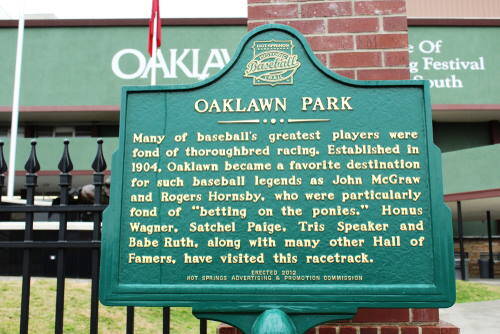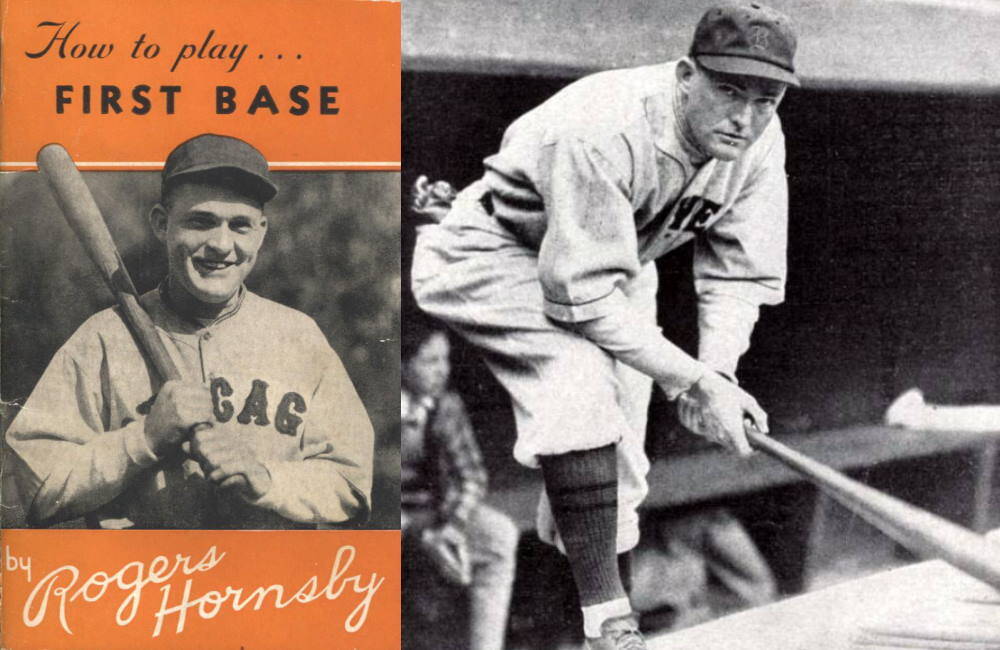Rogers Hornsby is considered one of the greatest hitters – and the best right-handed hitter – to ever take the field in Major League Baseball, with a lifetime batting average second only to Ty Cobb. After making his debut in 1915 at the age of 19, Hornsby played 23 seasons in the majors, most of it with two different teams in St. Louis.
Six Facts About Ty Cobb & His Career
Often overshadowed today by contemporaries Cobb and Babe Ruth, Hornsby is revered among knowledgeable baseball fans as one of the game’s all-time greats. To put Hornsby in context, the Texan’s lifetime batting average of .358 is slighter higher than that of Shoeless Joe Jackson (.355). It also beats other legends such as:
- Tris Speaker (.345)
- Ted Williams (.344)
- Babe Ruth (.342)
- Lou Gehrig (.340)
- Stan Musial (.331)
And those are all left-handed hitters. The only right-handed hitter with a lifetime batting average approaching Hornsby is Ed Delahanty (.346), who played from 1888-1903, mostly with the Philadelphia Phillies.
The story most often-repeated about Hornsby – one that shows what a great hitter he was and how much respect even the umpires had for him – goes like this: A pitcher once complained to legendary umpire Bill Klem after he called a close pitch to Hornsby a ball rather than strike three. On the next pitch, Hornsby deposited the ball in the outfield bleachers. As Hornsby jogged around the bases, Klem said to the young pitcher: “See, Mr. Hornsby will tell you when it’s close enough to be a strike.”
Rogers Hornsby’s Early Life
Like so many players of his generation, Hornsby came from humble roots. Unlike many of them, he didn’t start out looking like he was going to become an all-time great.
Rogers Hornsby was born April 27, 1896 in Winters, Texas, a small town about 40 miles south of Abilene. He grew up in Fort Worth, where his mother moved him and his four older siblings in 1902 after the death of his father. His mother, Mary, moved there so she and the older kids could get jobs in the meat-packing warehouses that had sprung up around the city’s cattle stockyards.
According to “Rogers Hornsby: A Biography” by Charles C. Alexander, the now-retired Distinguished Professor Emeritus of History at Ohio University, by the age of nine Hornsby already was leading a baseball team that wore blue flannel uniforms made by his mom. He wore the uniform constantly, even when playing in the yard.
When he reached 10, he started working as a messenger boy at the Swift & Company meat-packing plant. But he didn’t stop playing baseball. At 15, he played with adult players with the North Side Athletics in the Fort Worth City League. At North Side High School, starting in 1909, Hornsby played both baseball and football. But he dropped out after his sophomore year to work as the office boy for the Swift & Co. superintendent to help support the family.
Although it didn’t seem possible at the time, in just four short years he would be playing in the majors with the 1915 St. Louis Cardinals.
Playing (And Not Playing) in Dallas and Denison
Even while working at the plant, Hornsby continued to play baseball when he could. At 17, he tried out with the Dallas Steers of the Class B Texas League. The Steers signed him, but then released him two weeks later. It was the spring of 1914.
Many people might have given up at this point, but Hornsby loved playing baseball too much. He took a bus to Hugo, Oklahoma, about 130 miles northeast of Fort Worth, to try out for the Class D Texas-Oklahoma League team, the Hugo Scouts. The Scouts ended up signing him as shortstop. However, after just 51 games, the teamed folded on June 11, 1914.
Hornsby, however, did not come back home to Fort Worth. His contract had been sold to the Denison Champions of the Texas-Oklahoma League. He played for Denison, which is north of Dallas-Fort Worth on the Red River, for the rest of the 1914 season.
He didn’t play well, committing 45 errors and hitting just .232. According to teammates, the man who would become the greatest right-handed hitter in baseball history pleaded with them, asking, “Won’t somebody teach me how to hit?”
Rogers Hornsby in 1915
Hornsby started 1915 as a member of the Denison team, now in the Western Association and called the Denison Railroaders. Although he committed 58 errors playing shortstop, he hit .277 and helped the Railroaders win the Western Association pennant.
But the most important thing to happen that year in terms of his career occurred in the spring of 1915, when the St. Louis Cardinals played the Railroaders in a series of exhibition games. Hornsby’s play in that series caught the eye of scout Bob Connery, who had been instructed by Cardinals’ brass to find minor leaguers who could fill out the roster of the big league club.
The Cardinals, now one of baseball’s most storied franchises, were struggling both financially and on the field in 1915. They had not finished above third place since 1891, when they were still the original St. Louis Browns.
In September 1915, the Cardinals purchased Hornsby’s contract from the Railroaders. The team was on its way to a sub-.500 record and a sixth place finish in the National League. Hornsby’s first game came on Sept. 10, when he relieved starting shortstop Art Butler in the sixth inning. He went 0-for-2 at the plate.
He got his first hit in a game he started on Sept. 13 off Brooklyn Robins’ pitcher Rube Marquard. Hornsby finished the year with 57 at-bats, a .246 average, five runs scored, four runs batted in and no home runs. Again, he didn’t look like the player he was about to become.
Highlights of Hornsby’s Major League Career
Hornsby had to battle for the starting shortstop position in the 1916 spring training, outplaying Butler and outlasting Roy Corhan, who developed a shoulder injury.
Hornsby had spent the offseason back in Texas at his uncle’s farm, doing heavy labor and bulking up with chicken and steak. He returned in 1916 about 30 pounds heavier. He also had changed his approach at the plate, waiting better on balls.
In 1916, he hit .313, drove in 65 runs and scored 63. He had become the Rogers Hornsby we all know.
His exploits over the next 20-plus years are well known. He became known as “The Rajah” by fans (as with Ruth’s “Sultan of Swat” nickname, fans in that era used nicknames with a nod to Arabia). Some of the highlights include:
- National League batting champion every year from 1920-1925, and then again in 1928
- National League Most Valuable Player in 1925 and 1929
- National League Triple Crown winner in 1922 and 1925
- National League home run leader in 1922 and 1925
- National League RBI leader 1920-1922, and again in 1925
Perhaps most impressively, he hit over .400 in three separate seasons (1922, 1924 and 1925). Of all his years, 1922 may be the most impressive. His numbers: a .401 average, 42 home runs, 152 RBI and 141 runs scored.
In 1926, he led the Cardinals to the World Series championship as a player/manager. It was the first World Series championship for the Cardinals (they now have 11). The Cardinals defeated the New York Yankees. Hornsby ended the series by tagging out Babe Ruth, who tried to steal second base with two outs in the 9th inning of Game 7.
Hornsby left St. Louis after that season, going on to play for the New York Giants, Boston Braves and Chicago Cubs. He returned to St. Louis in 1933 as a member of the St. Louis Browns, playing there until he retired after the 1937 season.
Yankees World Series Wins 1903 - Present
Rogers Hornsby’s Personal Life
 Hornsby likely tarnished his own reputation during his player and manager days because of what others called an overbearing personality and extremely stubborn nature. Stories about this are legend. For example, he supposedly refused to slide into second base during the early days with the Cardinals because he felt he was too good to risk injury on such a lousy team. His dislike of Jack Hendricks caused the manager to get fired after the 1918 season.
Hornsby likely tarnished his own reputation during his player and manager days because of what others called an overbearing personality and extremely stubborn nature. Stories about this are legend. For example, he supposedly refused to slide into second base during the early days with the Cardinals because he felt he was too good to risk injury on such a lousy team. His dislike of Jack Hendricks caused the manager to get fired after the 1918 season.
Also, he didn’t return to the Cardinals after his 1926 championship year because while the club was willing to pay him the money he wanted, they stipulated that he must stay away from the horse track. He refused and ended up going to the Giants.
As it turned out, he had to keep working after retirement because he had lost so much money gambling. He didn’t last long in most jobs. Some of them included:
- Manager of the Oklahoma City Indians of the Texas League
- Manager of the Fort Worth Cats of the Texas League
- Player-Manager of the Veracruz Blues of La Liga Mexicana
- Spring training hitting instructor for the Chicago White Sox and Cleveland Indians
- TV announcer for Cubs games
- Manager of the Beaumont Roughnecks of the Texas League
- Manager of the Seattle Rainiers of the Pacific Coast League
Best MLB Announcers of All Time
After success in Beaumont and Seattle, he managed the St. Louis Browns in 1952. But the team fired him after he didn’t argue an umpire’s call on fan interference, although the real reason may have been that the players couldn’t stand him, saying he only spoke to them to criticize.
He went on to manage the Cincinnati Reds for two seasons, but also was fired from that job. He died Jan. 5, 1963, after suffering a stroke while undergoing cataract surgery at a hospital in Chicago. He was 66 years old. Hornsby is buried near his parents in the Hornsby Bend Cemetery, just east of downtown Austin near the Colorado River.


Leave A Comment